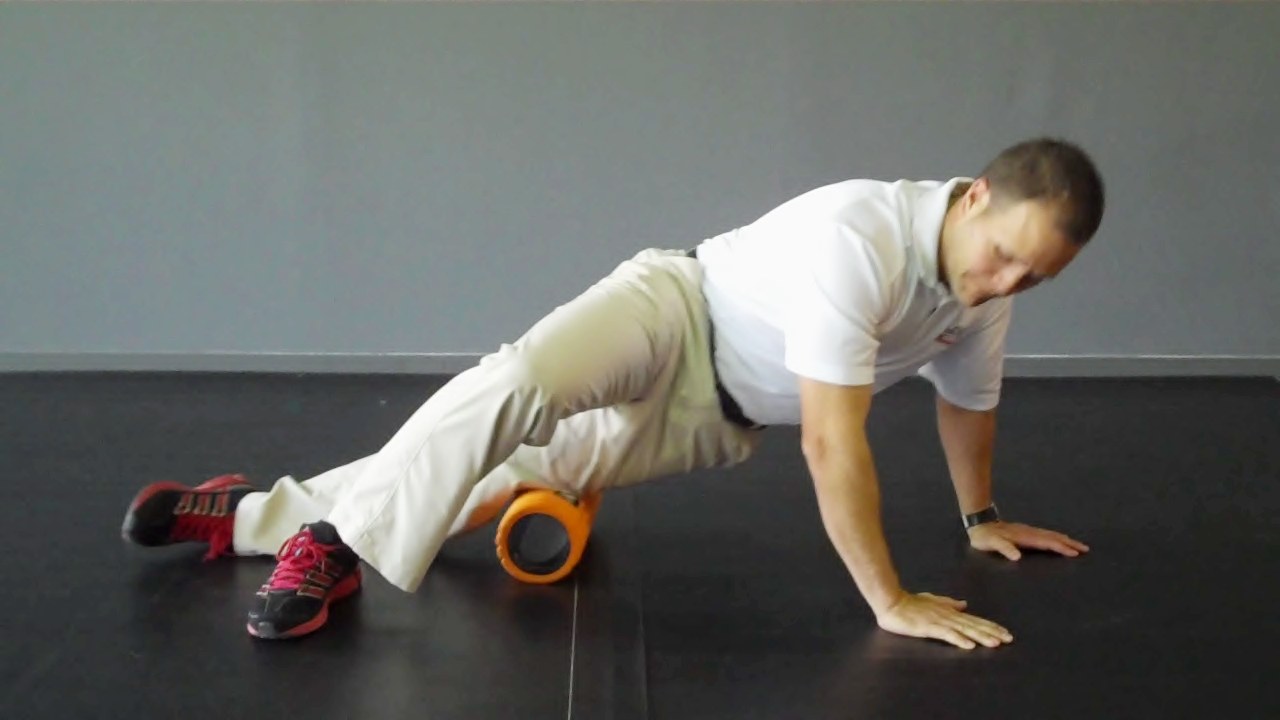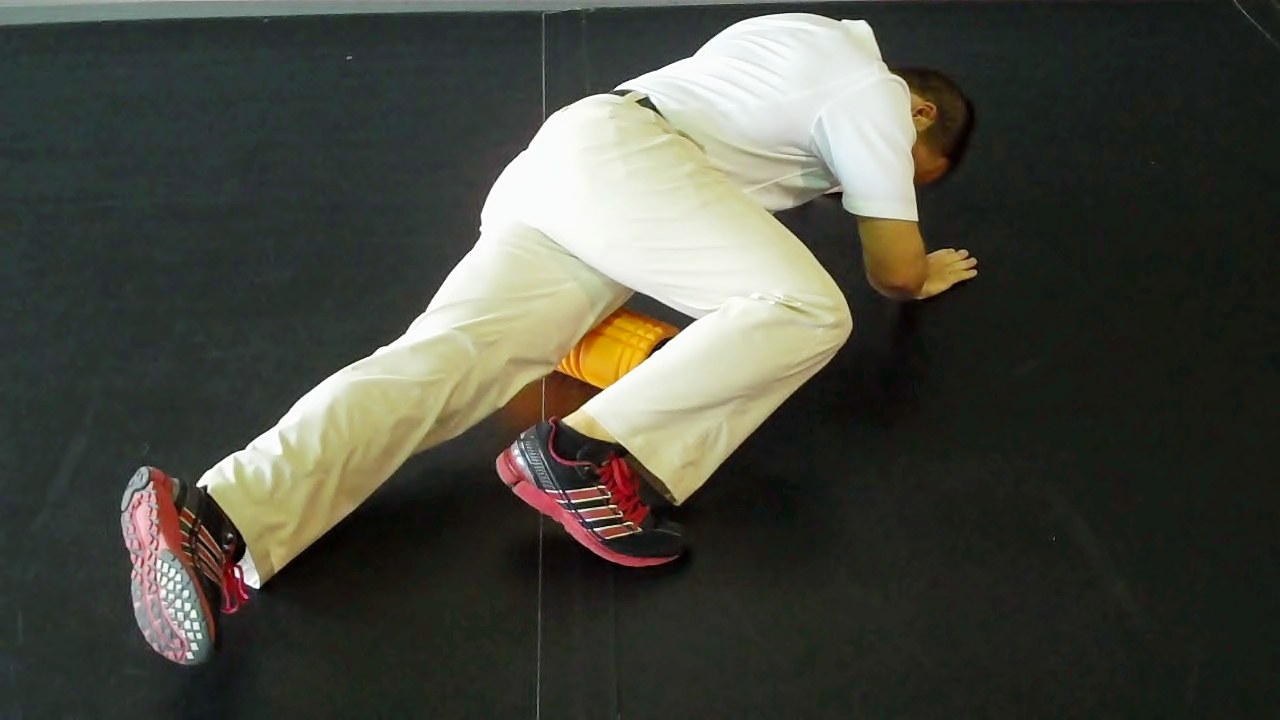
It is fairly well accepted in medical/rehab circles that much of the lateral knee pain felt by runners is related to the iliotibial band (ITB). Researchers report that frictional forces are greatest between 20 and 30 degrees of knee flexion (this occurs in the first part of stance phase with running). But what about the differences in hip and knee kinematics between healthy and injured subjects?
Historically, researchers have felt increased rear-foot eversion has contributed to such injuries. Why? Well, increased rear-foot eversion leads to increased tibial internal rotation, and by the ITB's attachment point distally on the tibia this would in turn increase stress (rubbing). In addition, it has been postulated that gluteus medius weakness leads to greater hip adduction moments and undue strain.
Running on one side of a road can also place undue stress on one side as the road is banked and this may cause the pelvis to shift to accommodate for a relative change in leg length during training. As such, varying the training course for runners is important. While these issues are common in runners, tightness and soreness may impact other athletes and the general population as well.
Anatomically, the tensor fascia lata (TFL) and gluteal muscles attach directly to the iliotibial tract. Proximally, the ITB attaches to the anterolateral iliac tubercle portion of the external lip of the iliac crest and distally it inserts on lateral condyle of the tibia. The primary role of the ITB is to act as a stabilizer during running/walking. Tightness/soreness may occur with running, walking, stairs and getting in/out of a seated position.
The first step in resolving pain along the band or lateral knee is releasing any fascial restrictions that may be present. This is very uncomfortable in many cases, so educating clients how to grade the pressure is important. I utilize a foam roller to achieve better mobility initially.
Execution:
Historically, researchers have felt increased rear-foot eversion has contributed to such injuries. Why? Well, increased rear-foot eversion leads to increased tibial internal rotation, and by the ITB's attachment point distally on the tibia this would in turn increase stress (rubbing). In addition, it has been postulated that gluteus medius weakness leads to greater hip adduction moments and undue strain.
Running on one side of a road can also place undue stress on one side as the road is banked and this may cause the pelvis to shift to accommodate for a relative change in leg length during training. As such, varying the training course for runners is important. While these issues are common in runners, tightness and soreness may impact other athletes and the general population as well.
Anatomically, the tensor fascia lata (TFL) and gluteal muscles attach directly to the iliotibial tract. Proximally, the ITB attaches to the anterolateral iliac tubercle portion of the external lip of the iliac crest and distally it inserts on lateral condyle of the tibia. The primary role of the ITB is to act as a stabilizer during running/walking. Tightness/soreness may occur with running, walking, stairs and getting in/out of a seated position.
The first step in resolving pain along the band or lateral knee is releasing any fascial restrictions that may be present. This is very uncomfortable in many cases, so educating clients how to grade the pressure is important. I utilize a foam roller to achieve better mobility initially.
Execution:
|
|
|
|
|
|
Additional Notes:
Keep in mind clients with signs of hip bursitis may not tolerate pressure up closer to the greater trochanter so you may need to limit the proximal rolling. It is also important to hit the TFL muscle belly as you roll higher and this is best accomplished with the hip in a more externally rotated position relative to the side lying start position.
As clients get used to the rolling, they may be able to elevate the top leg off the floor for added pressure and/or advance to a lacrosse ball, softball or smaller object for pin- point release once they can withstand more direct pressure.
The next column will specifically address stretching for the iliotibial band that should follow soft tissue release.
Brian Schiff, PT, CSCS, is a licensed physical therapist, respected author and fitness professional. Currently, he serves as the supervisor at the Athletic Performance Center in Raleigh, NC. Brian presents nationally at several professional conferences and seminars on injury prevention, rehab and sport-specific training. For more cutting edge training information, subscribe to his monthly Training & Sports Medicine Update at www.BrianSchiff.com.
 Begin in side lying with roller positioned just above the lateral knee. Cross the top leg over the under leg and place the foot of the top leg on the floor. In addition, place both hands on the floor to assist with rolling and unweighting the body to some degree.
Begin in side lying with roller positioned just above the lateral knee. Cross the top leg over the under leg and place the foot of the top leg on the floor. In addition, place both hands on the floor to assist with rolling and unweighting the body to some degree. Next, slowly roll up along the ITB up toward the hip. Then roll back down to the knee. Perform at least 10 repetitions or repeat for 60 seconds. The goal is to locate the "hot spots" and spend time releasing those areas of tightness.
Next, slowly roll up along the ITB up toward the hip. Then roll back down to the knee. Perform at least 10 repetitions or repeat for 60 seconds. The goal is to locate the "hot spots" and spend time releasing those areas of tightness. In addition, I suggest performing the motion with hip internal rotation and external rotation (pictured), relative to the initial start position, to get the edges of the band and soft tissue adjacent to it. Rolling should be performed daily.
In addition, I suggest performing the motion with hip internal rotation and external rotation (pictured), relative to the initial start position, to get the edges of the band and soft tissue adjacent to it. Rolling should be performed daily.













